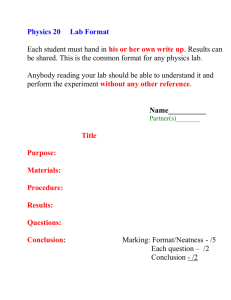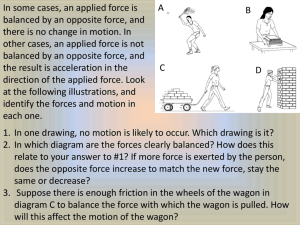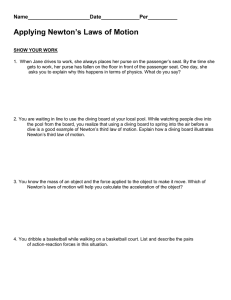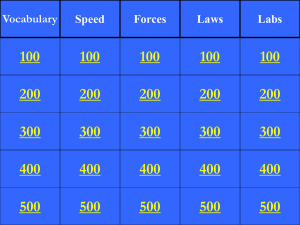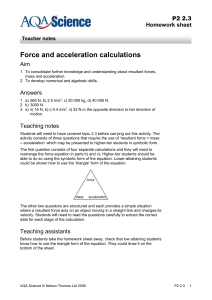Newton’s second law of motion
advertisement
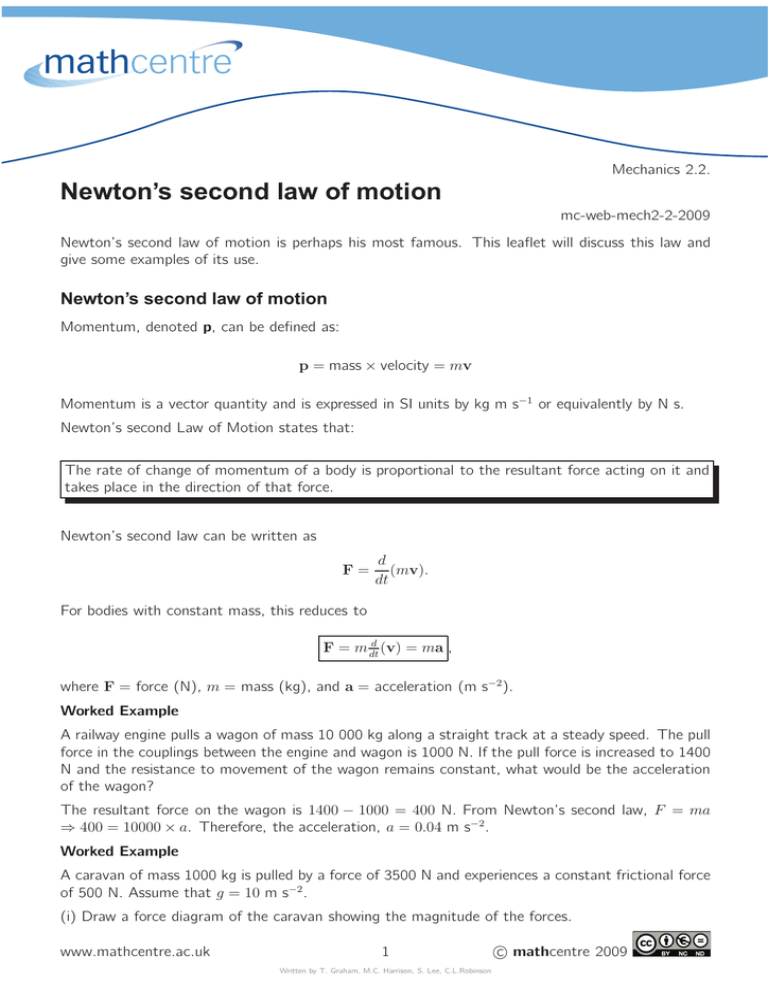
Mechanics 2.2. Newton’s second law of motion mc-web-mech2-2-2009 Newton’s second law of motion is perhaps his most famous. This leaflet will discuss this law and give some examples of its use. Newton’s second law of motion Momentum, denoted p, can be defined as: p = mass × velocity = mv Momentum is a vector quantity and is expressed in SI units by kg m s−1 or equivalently by N s. Newton’s second Law of Motion states that: The rate of change of momentum of a body is proportional to the resultant force acting on it and takes place in the direction of that force. Newton’s second law can be written as F= d (mv). dt For bodies with constant mass, this reduces to F = m dtd (v) = ma , where F = force (N), m = mass (kg), and a = acceleration (m s−2 ). Worked Example A railway engine pulls a wagon of mass 10 000 kg along a straight track at a steady speed. The pull force in the couplings between the engine and wagon is 1000 N. If the pull force is increased to 1400 N and the resistance to movement of the wagon remains constant, what would be the acceleration of the wagon? The resultant force on the wagon is 1400 − 1000 = 400 N. From Newton’s second law, F = ma ⇒ 400 = 10000 × a. Therefore, the acceleration, a = 0.04 m s−2 . Worked Example A caravan of mass 1000 kg is pulled by a force of 3500 N and experiences a constant frictional force of 500 N. Assume that g = 10 m s−2 . (i) Draw a force diagram of the caravan showing the magnitude of the forces. www.mathcentre.ac.uk 1 Written by T. Graham, M.C. Harrison, S. Lee, C.L.Robinson c mathcentre 2009 Figure 1: Force diagram of forces on caravan (ii) Calculate the magnitude and direction of the resultant force on the caravan. The resultant horizontal force = 3500 − 500 = 3000 N. (iii) Calculate the acceleration the caravan experiences. The force here, as calculated in part (ii), is 3000 N to the right and the mass of the caravan is 1000 kg. So we have that a = 3000/1000 = 3 m s−2 to the right. Worked Example An object of mass 60 kg is on a slope angled at 40◦ to the horizontal. Under the action of its own weight it accelerates down the slope. Neglecting any frictional force calculate the magnitude of its acceleration. R 50° X X Y Y 40° 600 N 600 N Figure 2: Force diagram of object accelerating down a slope Resolving the weight into its components of force, the force acting down the slope, X = 600 cos 50◦ = 386N (to 3 significant figures) and the force acting perpendicular to the slope Y = 600 sin 50◦ = 460N. From Newton’s second law in the direction of the slope, X = ma ⇒ 386 = 60 × a. Therefore, the acceleration a = 6.43 m s−2 . Exercises 1. A resultant force of 16 N causes a mass to accelerate at a rate of 5 m s−2 . Determine the mass. 2. Find the acceleration of a 16 kg box along a horizontal floor when it is pushed with a resultant force of 8 N parallel to the floor. 3. An object of mass 40 kg is on a slope angled at 30◦ . Under the action of its own weight it accelerates down the slope. Neglecting any frictional force calculate the magnitude of its acceleration. (Assume g = 10 m s−2 ). Answers 1. m = 3.2kg 2. a = 0.5 m s−2 www.mathcentre.ac.uk 3. a = 5 m s−2 2 Written by T. Graham, M.C. Harrison, S. Lee, C.L.Robinson c mathcentre 2009
